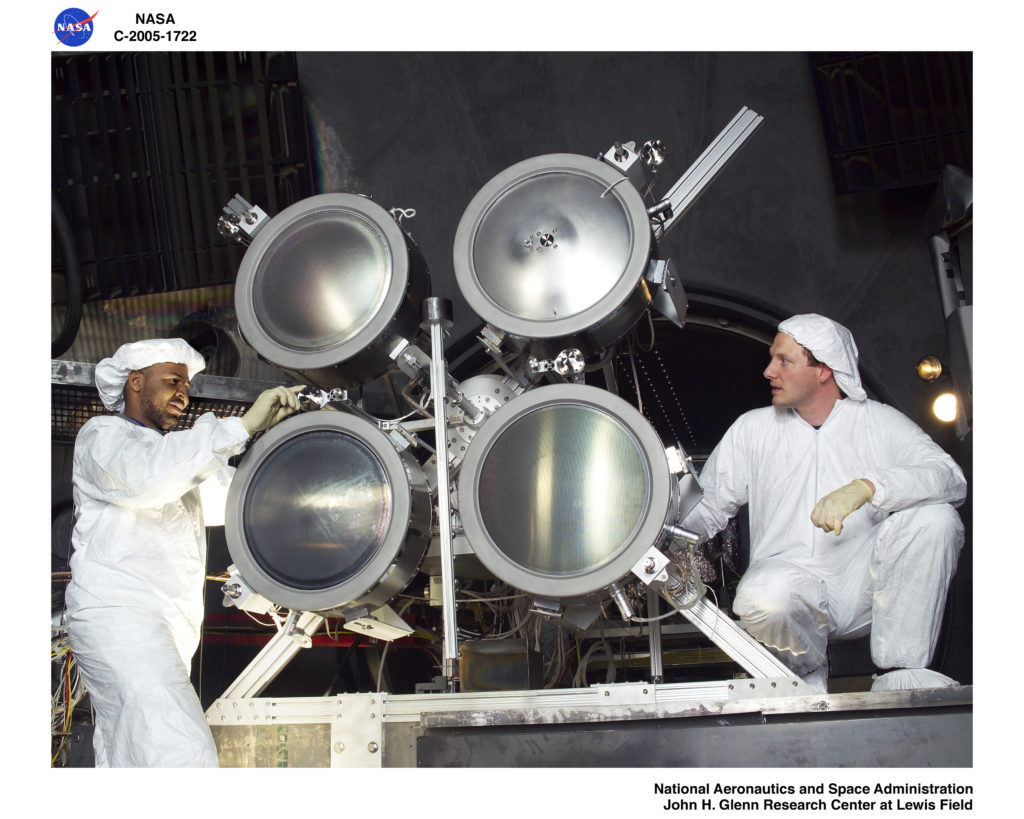
Intercepting an asteroid
In prior posts, two Michigan Engineers worked on the ion engine aboard NASA’s DART probe, set to launch this winter.

In prior posts, two Michigan Engineers worked on the ion engine aboard NASA’s DART probe, set to launch this winter.
A couple of years before the disaster movie duo of Armageddon and Deep Impact hit cinemas in the late ’90s, NASA funded its first experiment in planetary defense, known as the Double Asteroid Redirection Test. DART aims to avoid those doomsday plots by testing a “kinetic impactor” deflection approach before Earth actually needs it. The spacecraft launches this winter and is set to crash-land on an asteroid moonlet known as “Didymos B,” 6.8 million miles away in fall 2022.
Two researchers who are now at Michigan Engineering played key roles in developing DART’s ion engine, the most advanced, fuel efficient thruster to leave the planet. John Foster, now a professor of nuclear engineering and radiological sciences, and Jonathan Van Noord, now a lead mechanical engineer in the Space Physics Research Laboratory, contributed to DART during their time at NASA Glenn Research Center.
The Michigan Engineer talked to Foster and Van Noord about the plan to knock an asteroid into a different orbit and what it means to see the engine they worked on make it to space.

Foster: If an asteroid’s orbit takes it on a trajectory that intersects with Earth, we’d want to shift it so that it cuts through Earth’s orbit at an earlier or later time, missing the planet. You need to speed up or slow down the asteroid’s orbit around the sun.
The DART mission is aiming for a binary asteroid system, with a little asteroid orbiting around a bigger one with a slow orbital speed. It’s purely a demonstration一these asteroids don’t pose a threat. The main asteroid, Didymos A, is about 750 meters, or .45 miles, across. And its “moonlet” Didymos B is about 150 meters, or .09 miles, across. If you crash something into the little one, you can perturb its orbit—you slow it down a little.
Even though Didymos B is little for an asteroid, it’s still big. A football field is about 100 meters. The DART probe weighs about 1,100 pounds, but it’s going about 13,000 mph. That’s pretty fast. You’re hitting the asteroid with this little thing, but it’s going fast enough to deflect it. The change will be tiny, on the order of a millimeter per second, but advanced telescopes will be able to see that change. This proof of concept will allow us to design and predict the requirements to actually deflect larger asteroids that would otherwise be on a collision course with us.
Van Noord: John and I helped design and test the NEXT thruster, under the leadership of Mike Patterson. It will fly for the first time on the DART mission. DART also has a chemical propulsion system.
NEXT-C is a gridded ion thruster, a type of electric propulsion system. It was developed by NASA and handed off to Aerojet Rocketdyne for commercialization. It’s much more efficient than chemical systems, but mission planners are nervous about using a new technology that hasn’t been tested in space yet. We should see the NEXT-C thruster run in the DART mission, possibly participating in the trajectory correction maneuvers.
Foster: The NEXT engine more than triples the power of its predecessor, NSTAR, used on the Dawn and Deep Space 1 missions. Jonathan’s team tested it for more 50,000 hours, showing that it could fly for more than five years. We also ran three of them together at Vacuum Chamber 6 at NASA Glenn, along with one dormant engine for backup, to simulate the way they might run on a mission to Saturn’s moon, Titan. It’s painful to crash it into an asteroid when it is capable of so much more! But the DART mission will be a good demonstration.
Van Noord: We’re not the only Michigan people who worked on NEXT. The project included five other Michigan alumni—and many, like me, came through the Plasmadynamics and Electric Propulsion lab.
Foster: NEXT-C is the highest performance plasma thruster system on the market right now. It’s on the shelf and ready to go. It can be used for orbit transfer—for instance raising a satellite to a geosynchronous orbit so that it stays over the same location on Earth. It can be used for station keeping, or keeping communications satellites in the right location with respect to others in their network.
It can also be a workhorse engine for robotic missions throughout the solar system. Exciting space science missions include bringing back samples from comets and planets, exploring Titan, or powering a deep space telescope. Honestly, you can use it for almost any outer planet rendezvous. It has the performance and lifetime to get you there
Van Noord: Basically, by being extremely fuel efficient, NEXT-C opens up missions that would have been cost or mass prohibitive due to the amount of fuel they required. This lends its use to deeper space missions or missions that would require a large amount of energy to change their orbits.
For example, most of our missions to date happen in the ecliptic plane, the imaginary plane containing the planets’ orbits around the sun. There is a lot of “dust” in the ecliptic plane and rising up out of it would allow for even better viewing out of our solar system. But it takes a lot of fuel to get a spacecraft out of the ecliptic plane since they have almost no momentum in that direction when they launch. NEXT-C would be ideal for a mission that would position a telescope in an orbit outside the ecliptic plane.